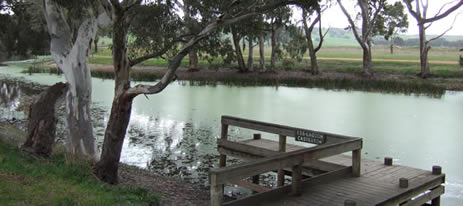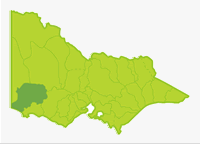Glenelg
- Bong Bong Lake
- Clear Lake
- Coleraine Lagoon
- Crawford River
- Dunkeld Arboretum Dam
- Ess Lagoon
- Freshwater Lake
- Glenelg River
- The Glenelg Estuary
- Grampians National Park Streams
- Grange Burn
- Greenwald Reservoir
- Hamilton Lake
- Kangaroo Creek
- Konong Wootong Reservoir
- Linlithgow Lake
- Mombeong Lake
- Muddy Creek
- Old Hamilton Reservoir
- Rocklands Reservoir
- Stokes River
- Walker Swamp
- Wannon River

This basin has a wide range of land types, vegetation and land use. The far north-east, including the headwaters of the Wannon and Glenelg Rivers and the western flanks of the Grampians National Park, are steep hills with mixed species low forest and heathland scrub. The remainder of the Basin is flat farmland except for an area of hills (1,000 km²) around Casterton.
Most of the Basin receives a low mean annual rainfall (500-700 mm) with a higher rainfall (700-1,000 mm) southwest of Casterton. Much of the area, particularly in the northwest and along the Glenelg River, is fairly inaccessible. The basin is drained by one of the largest rivers in Victoria, the Glenelg, which flows into the sea at Nelson. Rivers in the Basin have a sluggish flow and mud or sand bottoms. There is an accumulation of sediment in the top of the Glenelg River estuary which has reduced habitat in that area. Further downstream the river in the Lower Glenelg National Park is in excellent condition. Salinity in the main rivers reaches very high levels downstream. This is due to dry land salting caused by removal of natural vegetation.
Trout fishing is largely dependent on stocking. The freshwater sections of the rivers are probably not worth a special trip to fish. European carp were detected in Rocklands Reservoir and in the river below the reservoir in 2000. The Glenelg River Basin was up until then one of the last 'European carp free' river basins in Victoria. Some waters in this Basin are commercially fished for short-finned eel.
Freshwater Fish in the Basin
Native species
- (Large fish): Estuary perch, Glenelg spiny crayfish*, Macquarie perch, river blackfish, river blackfish (upper Wannon River form), and short-finned eel.
- (Small fish): Australian smelt, bluespot goby, common galaxias, congoli, easterndwarf galaxias, Ewens pygmy perch, flathead gudgeon, mountain galaxias, shorthead lamprey, smallmouth hardyhead, trout galaxias, southern pigmy perch, western carp gudgeon and Yarra pygmy perch.
Introduced species
- Brown trout, eastern gambusia, European carp, goldfish, rainbow trout, redfin and tench.
Native species in bold are protected in this Basin. Introduced species in bold are declared noxious.
*The Glenelg spiny crayfish, Euastacus bispinosus,inhabits the Glenelg River and its tributaries and extends up into headwater tributaries. It occurs in streams with good riparian vegetation. It is prohibited to take (or attempt to take) Glenelg spiny crayfish from Victorian waters. The fishery has been closed because of sustainability concerns for this species.
Management
See Introduction for information on Management Agencies and Programs.
The Victorian Fisheries Authority
- manages stocking, fisheries policy, compliance with fisheries regulations and contact with anglers.
- Fisheries Management Plan (FMP) (a recent project that provides recreational anglers, government agencies and other stakeholders with clear guidance on fisheries management issues with a regional area over a five year period).
A FMP for waters within this Basin has been completed and was declared in October 2006. It can be viewed on the website. Fisheries Victoria Report Series. Glenelg Hopkins FisheryManagement Plan. No. 42. October 2006. - Stocking Program (stocking plans for desirable species are based on an approved Victorian Fisheries Authority stocking policy and are reviewed annually via Vic Fish Stock). In this Basin, Hamilton Lake and the Konong Wootong Reservoir are the only waters being stocked with trout.
Up-to-date information on numbers and size of each species stocked can be found under Fish Stocking in the Fisheries and Aquaculture section of this website or in the annual Vic Fish Stock Report published by the department. - Family Fishing Lakes Program (an ongoing project of stocking small waters within urban areas with larger trout, for junior and disabled anglers – see Introduction for further information). Waters in this Basin are Coleraine Lagoon, Dunkeld Arboretum Dam and Ess Lagoon.
- Victorian Stream Classification (a project that was completed in November 2010, which classifies each water as a native, salmonid or mixed fishery). Classifications relevant to this basin are:
- Mixed- Rocklands Reservoir, Konong Wootong Reservoir (Lake) and Lake Hamilton
- Native- all other waters.
Glenelg Hopkins Catchment Management Authority
- is responsible for catchment management and the River Health Program.
- Victorian River Health Program (an on-going State Government initiative to achieve healthy rivers, streams and floodplains). Major activities are erosion control, bed and bank stabilization, willow and weed removal, fencing and replanting banks. Works have been carried out on Crawford, Glenelg and Stokes Rivers.
Gippsland and Southern Rural Water
- manages rural water diversion for irrigation/stock use and the development of Stream Flow Management Plans.
- Stream Flow Management Plans (an ongoing project in which various agencies and water user's develop a flow sharing arrangement which ensures an adequate environmental flow allocation for each river in Victoria). There are none in this Basin.
Wannon Water
- manages urban diversion and supply
Best Fishing Waters
| Water | Target Species |
|---|---|
| Konong Wootong Reservoir | Brown trout, rainbow trout |
| Glenelg River estuary | Estuarine species |
| Rocklands Reservoir | Redfin, trout |
Special Values
Heritage River Areas
The section of the Glenelg River from Dartmoor to the sea (excluding the section in South Australia) has been listed.
Threatened fish Species
The easterndwarf galaxias, Ewens pygmy perch, Macquarie Perch, river blackfish (upper Wannon River form) and Yarra pygmy perch are listed as threatened species in Victoria. (Department of Sustainability and Environment [DSE] Dec. 2007). A list of Victorian threatened species together with scientific names of species and a definition of the terms used and their national status is available on the DSE web site.
Species in bold type as well as the Glenelg spiny crayfish are also listed under the Flora & Fauna GuaranteeAct 1988. These species cannot be taken or kept within Victoria without an appropriate written order, licence or permit.

